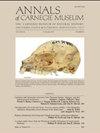Lithofacies and Fauna of the Loyalhanna Limestone (Chesterian, Upper Mississippian) and Their Implications for its Origin in the Appalachian Basin
IF 0.9
4区 地球科学
Q4 PALEONTOLOGY
引用次数: 0
Abstract
ABSTRACT The Loyalhanna Limestone is one of the most recognizable rock units in the Appalachian Basin. Differential weathering of its large-scale cross-bedding and massive character make this unit a widely used dimension and quarry stone. Diverging thoughts on the origin of the iconic cross-bedding have led to a long-standing debate over whether the genesis of the Loyalhanna is eolian or marine. Diagnostic bedding characters exhibited by the Loyalhanna are equivocal with most features possible in environments of both subaerial or subaqueous dune formation. Other diagnostic subaerial textures such as exposure surfaces, translatent ripple laminates, tracks, and trails are unknown in the unit. However, the Loyalhanna does contain a number of features that can be attributed to subaqueous deposition. For example, endolithic algal borings and coatings are ubiquitous. The Loyalhanna Limestone also displays a north-to-south change in lithofacies characteristics. Along its northern and eastern boundaries, the typically massive Loyalhanna is interbedded with rippled sandstone and red to variegated shale. Near its southern geographic limits, the Loyalhanna is interbedded with nodular, argillaceous, fossiliferous limestone intervals. Between these two interbedded lithofacies, the unit consists of the typical massive, cross-bedded, sandy limestone. Petrographically, the Loyalhanna contains a common microfauna of endothyrid foraminifers, and fragmented brachiopods, bryozoans, and echinoderms. A macrofauna was noted at eight locations. This fauna consists of articulated brachiopods, gastropods, bivalves, and trilobites. At other locations, comminuted megafauna assemblages are widespread. These fragmental faunas are known even in north-central and northeastern Pennsylvania. The presence of marine micro- and megafossils from throughout the Loyalhanna depositional basin and the equivocal nature of the eolian features indicate that this unit is largely if not completely marine in origin.阿巴拉契亚盆地上密西西比切斯特系Loyalhanna灰岩的岩相、区系及其成因意义
洛亚汉纳石灰岩是阿巴拉契亚盆地最知名的岩石单元之一。其大规模交错层理和块状的差异性风化特性,使该单元成为广泛使用的尺寸和采石场。关于标志性的交叉层理的起源的不同观点导致了一个长期的争论,即洛亚汉纳的起源是风成的还是海洋的。洛亚尔汉纳的诊断层理特征是模棱两可的,大部分特征可能存在于陆上或水下沙丘形成环境中。其他诊断地面纹理,如暴露表面,跨潜波纹层压板,轨迹和痕迹是未知的单位。然而,Loyalhanna确实包含了一些可以归因于水下沉积的特征。例如,内石器时代的藻类钻孔和涂层无处不在。洛亚尔汉纳灰岩的岩相特征也呈现由北向南的变化。在其北部和东部边界,典型的巨大的洛亚尔汉纳与波纹砂岩和红色到杂色页岩互层。在其南部地理边界附近,Loyalhanna与结节状、泥质、化石石灰岩互层。在这两个互层岩相之间,该单元由典型的块状、交错层状砂质灰岩组成。岩石学上,洛亚汉纳包含一个常见的胸腺内有孔虫、破碎的腕足动物、苔藓虫和棘皮动物的微动物群。在8个地点发现了大型动物群。该动物群包括关节腕足类、腹足类、双壳类和三叶虫。在其他地方,粉碎的巨型动物群落分布广泛。甚至在宾夕法尼亚州中北部和东北部也发现了这些零散的动物群。来自整个洛亚尔汉纳沉积盆地的海洋微化石和巨型化石的存在以及风成特征的模棱两可性质表明,该单元的起源即使不完全是海洋的,也很大程度上是海洋的。
本文章由计算机程序翻译,如有差异,请以英文原文为准。
求助全文
约1分钟内获得全文
求助全文
来源期刊

Annals of Carnegie Museum
综合性期刊-动物学
CiteScore
2.50
自引率
18.20%
发文量
4
审稿时长
>12 weeks
期刊介绍:
Annals of Carnegie Museum is a quarterly journal that publishes peer-reviewed short and medium-length original scientific contributions in organismal biology, earth sciences, and anthropology, in 40 by 52.5 pica format (168 by 220 mm or 6-5/8 by 8-5/8 inches). Subject matter must be relevant to Carnegie Museum of Natural History scientific sections or Powdermill Nature Reserve (PNR), preferably with connection to the Carnegie collection and/or personnel. Carnegie Museum staff and research associates receive publication priority, but others are encouraged to submit papers, especially those manuscripts explicitly based on the Carnegie collection.
 求助内容:
求助内容: 应助结果提醒方式:
应助结果提醒方式:


